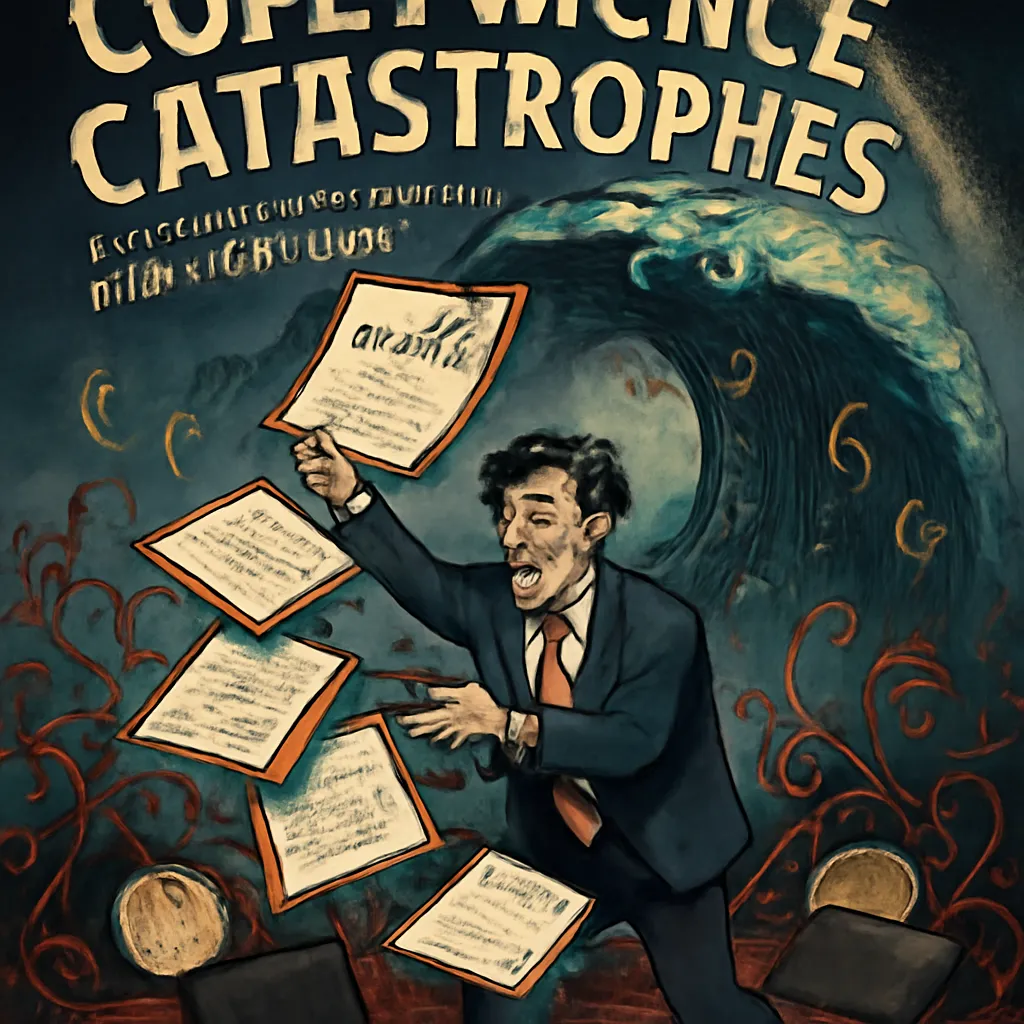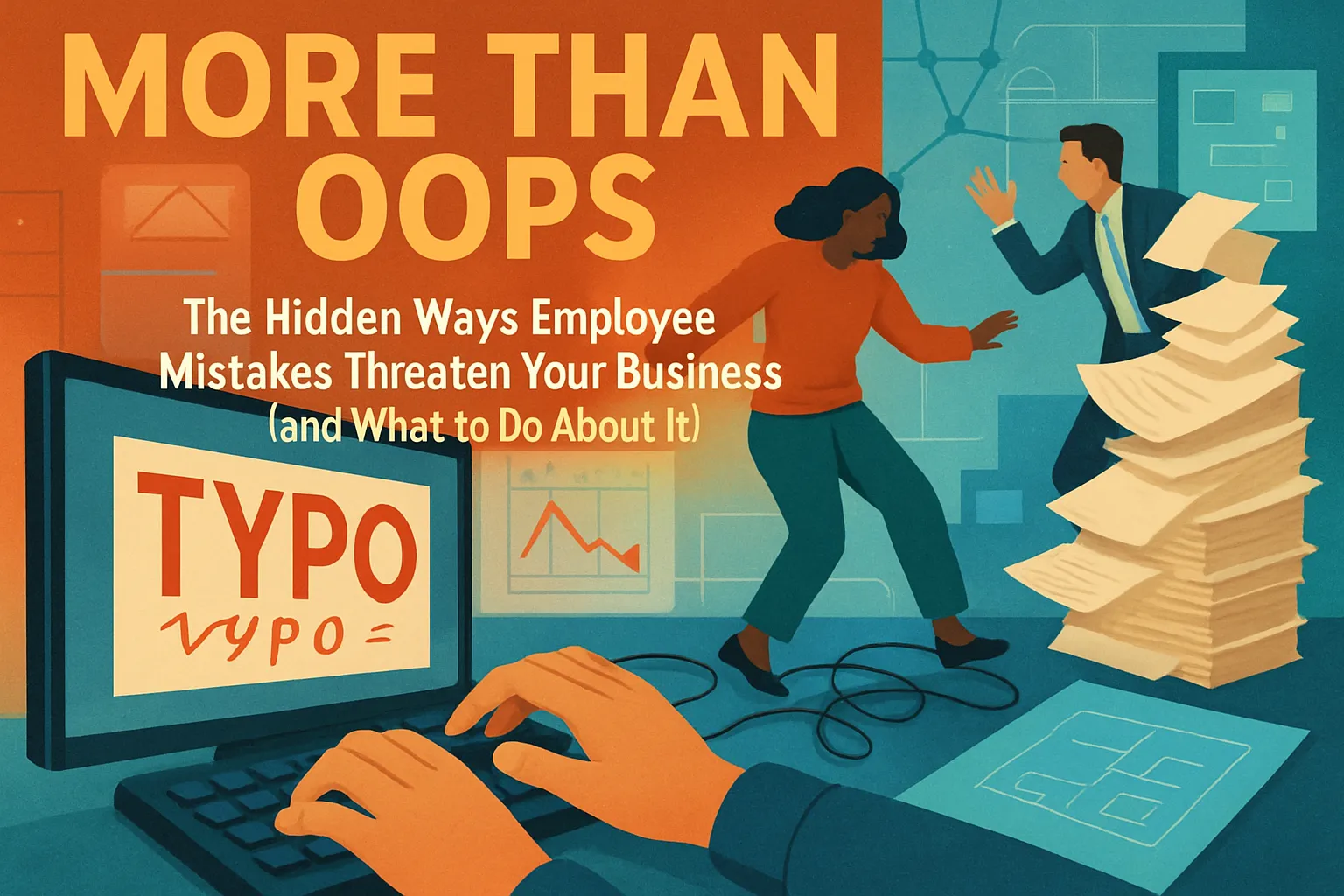Some mornings, it only takes one typo to send your company scrambling—for me, it was an extra zero in payroll that nearly tanked the budget (don’t ask). But here’s the gut-punch: small, all-too-human mistakes like mine happen every day, costing businesses far more than embarrassment. From wild burnout rates to head-scratching HR fines, this post explores the messier, hidden fallout of employee errors, and what you can actually do—besides crossing your fingers. Wild Card: Imagine if your business ran on autopilot—no slipups, no oversights. But would anyone even show up? Are mistakes just the price of being human at work?
The Snowball Effect: Tiny Errors, Titanic Consequences (Human Error Impact)
It’s easy to dismiss a small mistake at work—a missed checkbox, a misplaced decimal, or a forgotten attachment. Yet, these seemingly minor slip-ups can trigger a chain reaction, leading to consequences far beyond a simple correction or apology. According to human error statistics 2025, a staggering 80% of business process failures are caused by human mistakes. This figure highlights just how vulnerable organizations are to everyday errors.
Consider the cost of employee mistakes in real-world terms. One infamous example is the accounting typo that led to a $225 million loss for a major firm. A single extra zero—or the lack of one—can transform a routine transaction into a financial disaster. Such financial losses from employee errors don’t just impact the bottom line; they can also damage a company’s reputation and erode client trust.
Why Small Errors Spiral Out of Control
Why do common workplace errors escalate so quickly? The answer lies in the interconnected nature of modern business systems. When one person makes a mistake, it often goes unnoticed until it interacts with other processes—like a domino effect. Deadlines, high workloads, and stress only increase the risk. For example:
- Unchecked data entry can corrupt entire databases, affecting reports and decisions.
- Missed safety steps can lead to accidents or compliance violations.
- Misfiled documents can delay projects and frustrate clients.
The employee mistakes business risk is often underestimated until it’s too late. What starts as a minor oversight can snowball into lost contracts, regulatory fines, or even legal action. The true cost of employee mistakes includes not just immediate losses, but also the time and resources spent on damage control.
The Myth of Perfection
It’s tempting to believe that perfection is the answer—if only every employee could avoid mistakes, the business would be safe. However, obsessing over every slip-up can create a culture of fear and hesitation, making things worse. As usability expert Donald Norman wisely said:
"We can’t eliminate mistakes, but we can design workplaces that make the right action easier than the wrong one."
Understanding the employee mistakes business risk means recognizing that errors are inevitable. The key is to build systems and cultures that catch mistakes early, minimize their impact, and turn lessons into improvements. In today’s fast-paced environment, even the smallest error can have titanic consequences—so awareness and prevention are more important than ever.

Burnout: The Quiet Catalyst for Costly Workplace Mistakes
Employee burnout levels are quietly fueling a surge in workplace errors that can threaten any business. Burnout is more than just feeling tired—it’s a state where employees operate on “autopilot,” making mistakes they would never normally make. Recent research shows that 64% of employees report feeling burned out at least weekly. This chronic exhaustion doesn’t just sap morale; it directly increases the risk of costly errors that can slip under the radar until it’s too late.
When burnout sets in, the impact is immediate and far-reaching. Absenteeism jumps by 23%, and healthcare spending soars as employees struggle with stress-related illnesses. These numbers aren’t just statistics—they represent real risks to business stability and productivity. The workplace errors impact business in ways that go beyond simple “oops” moments. Missed deadlines, forgotten tasks, and compliance slip-ups can all be traced back to overworked, disengaged teams.
Employee Disengagement: The Hidden Multiplier of Mistakes
Burnout and employee disengagement go hand in hand. Today, only 30% of employees feel truly engaged at work, a record low that compounds the cost of employee mistakes. Disengaged employees are more likely to overlook details, ignore safety protocols, or miss critical communications. As Marcus Buckingham notes:
"A disengaged team doesn’t just slow down—mistakes multiply."
When engagement drops, so does attention to detail. The employee disengagement impact is felt in every department, from customer service to compliance, amplifying the risk of expensive errors.
Personal Anecdote: When Burnout Hits Home
Consider a real-world example: After months of chronic overtime, the author’s team missed a crucial contract renewal. The culprit? Mental fog from burnout. No one caught the reminder email, and the oversight led to lost revenue and a scramble to repair the client relationship. This is a classic case of how employee engagement challenges and burnout can quietly sabotage even the most diligent teams.
Mistakes Are Contagious in a Burned-Out Team
Burnout doesn’t just affect individuals—it spreads through teams like a bad cold. When one employee starts making errors, others often follow, either through distraction or by picking up extra work to cover for absent colleagues. This creates a cycle where workplace errors impact business productivity and well-being, driving up business risk assessment numbers and increasing costs across the board.
- 64% of employees report weekly burnout
- 23% increase in absenteeism due to burnout
- Only 30% of employees are actively engaged
Understanding and addressing burnout is essential to reducing costly mistakes and protecting your business from hidden risks.

Compliance Catastrophes: The Lurking Financial Tsunami from HR Slipups
For many small businesses, HR compliance challenges are like hidden reefs—easy to overlook until disaster strikes. The numbers are sobering: small businesses lose an average of $10,000 per year from HR non-compliance alone. But that’s just the tip of the iceberg. When HR compliance penalties go unchecked, costs can quickly escalate into the millions, threatening the very survival of a business.
How Innocent Mistakes Become Expensive Nightmares
It’s easy to think of compliance as a box to check, but the reality is far more complex. Even a single overlooked regulation or outdated policy can trigger a cascade of issues. Consider a hypothetical: What if your employee handbook hasn’t been updated since 2015? That seemingly minor oversight could be a compliance time bomb, exposing your business to lawsuits, audits, and regulatory fines.
"HR is either your first line of defense—or your weakest link." – Patty McCord
Manual Data Entry: The Hidden Risk Multiplier
Manual processes are a major source of employee mistakes business risk. Research shows that manual data entry is up to 100 times more error-prone than automated systems. Each typo or missed field can lead to incorrect payroll, misreported taxes, or even data breaches. The costs of a data breach—both in fines and lost trust—can be devastating, especially for small businesses with limited resources.
Why Small Business HR Challenges Carry Outsized Impact
- Regulatory Complexity: With ever-changing labor laws, staying compliant is a moving target.
- Resource Constraints: Small teams often juggle multiple roles, increasing the risk of oversight.
- Compliance Risk Management: Proactive management isn’t just about avoiding fines—it’s about protecting sensitive employee data and company reputation.
Potential Penalties: The Real Cost of Non-Compliance
- Annual average loss: $10,000 for small businesses
- Major penalties: Can reach millions for severe violations
- Data breach costs: Fines, legal fees, and reputation damage
Ignoring compliance risk management can turn a small HR error into a full-blown financial tsunami. Employee mistakes in compliance—whether due to outdated policies or manual data entry—can spiral into larger business risks, threatening both financial stability and long-term growth.

The Slipstream of Disengagement: From Quiet Cracking to Productivity Crashes
In the evolving landscape of workplace culture 2025, a subtle yet powerful trend is reshaping how companies experience risk: the phenomenon of quiet cracking. Unlike the more visible forms of employee disengagement, quiet cracking describes a silent retreat—where over half of U.S. workers are pulling back from their roles, often triggered by job insecurity or a lack of growth opportunities. This disengagement is not just a morale issue; it is a direct threat to business performance and resilience.
Quiet Cracking: The Hidden Cost of Disengagement
Recent research highlights that over 50% of the workforce now shows signs of quiet cracking. The employee disengagement impact is staggering: companies lose an estimated 34% of each disengaged employee’s annual salary in lost output, errors, and missed opportunities. As Josh Bersin aptly puts it:
“Engagement isn’t a party trick—it’s an insurance policy against mistakes.”
Disengaged employees are more likely to make costly mistakes, overlook details, and contribute to a culture where errors become normalized.
Real-World Ripple Effects
Consider the experience of a peer’s business that shifted to remote work without any re-onboarding or adaptation. Within weeks, avoidable errors surged—deadlines were missed, client information was mishandled, and team morale plummeted. This scenario is a textbook example of how employee engagement challenges can quickly escalate into operational risks and financial losses.
Engagement Mistakes to Avoid
Many organizations fall into common traps that worsen the employee mistakes cost:
- Ignoring hybrid work needs: Failing to support remote and hybrid employees leads to isolation and confusion.
- Forgetting professional development: Employees who see no path for growth are more likely to disengage and underperform.
- One-size-fits-all policies: Uniform approaches ignore individual needs and circumstances, fueling quiet cracking.
Adapting to the New Engagement Reality
The employee disengagement impact extends far beyond lost productivity. It increases error rates, damages reputation, and raises compliance risks. As employee engagement challenges shift rapidly in the 2025 workplace, leaders must recognize that preventing mistakes requires more than rules—it demands adaptive, inclusive engagement strategies that address the root causes of quiet cracking.
Don’t Just Fix—Rethink: Preventing Employee Mistakes Without Killing Innovation
When it comes to employee mistakes prevention, the goal is not to create a workplace where errors are impossible. Instead, the focus should be on building a culture where employees feel supported to learn, grow, and innovate—without putting the business at unnecessary risk. Too often, organizations respond to mistakes with stricter rules and closer monitoring, but this can stifle creativity and lead to a fearful, less productive environment. As Amy Edmondson wisely said,
"The businesses that bounce back fastest are the ones that encourage learning, not blame."
Research shows that employee training reduces risks and supports business safety. In fact, companies that invest in proper training programs cut the average cost of data breaches by $260,000. This is a clear sign that employee training effectiveness is not just about compliance—it’s about empowering employees to make smarter decisions and feel confident in their roles. When employees understand the “why” behind policies and procedures, they are less likely to make anxiety-driven mistakes and more likely to contribute positively to the company’s goals.
But employee mistakes risk mitigation is not about policing every move. Instead, it’s about creating safety nets that catch small errors before they become big problems. Smart technology, such as automated alerts and access controls, can help prevent costly slip-ups without micromanaging staff. Open feedback channels encourage employees to report near-misses and mistakes, turning potential disasters into valuable learning moments. Rewarding transparency and treating errors as opportunities for growth helps build a resilient organization.
It’s important to remember that perfection is unrealistic. Employee behavior risk assessment must account for human nature. If your workplace demanded zero mistakes, would your best idea have ever happened? Innovation thrives in environments where people feel safe to experiment, even if that means occasionally getting it wrong. The most successful businesses strike a balance between employee mistakes solutions and creative freedom, using training and compliance management as tools for both safety and growth.
In conclusion, preventing employee mistakes is less about rigid control and more about thoughtful support. By investing in effective training, leveraging smart technology, and fostering a culture of open communication, organizations can reduce the business impact of employee mistakes while still encouraging innovation. After all, the path to progress is paved with both successes and well-managed missteps.
TL;DR: Employee mistakes are inevitable, but understanding root causes (culture, stress, poor training) can turn risk into opportunity. With better engagement, clear policies, and smarter prevention, you don’t just put out fires—you help your business thrive.



